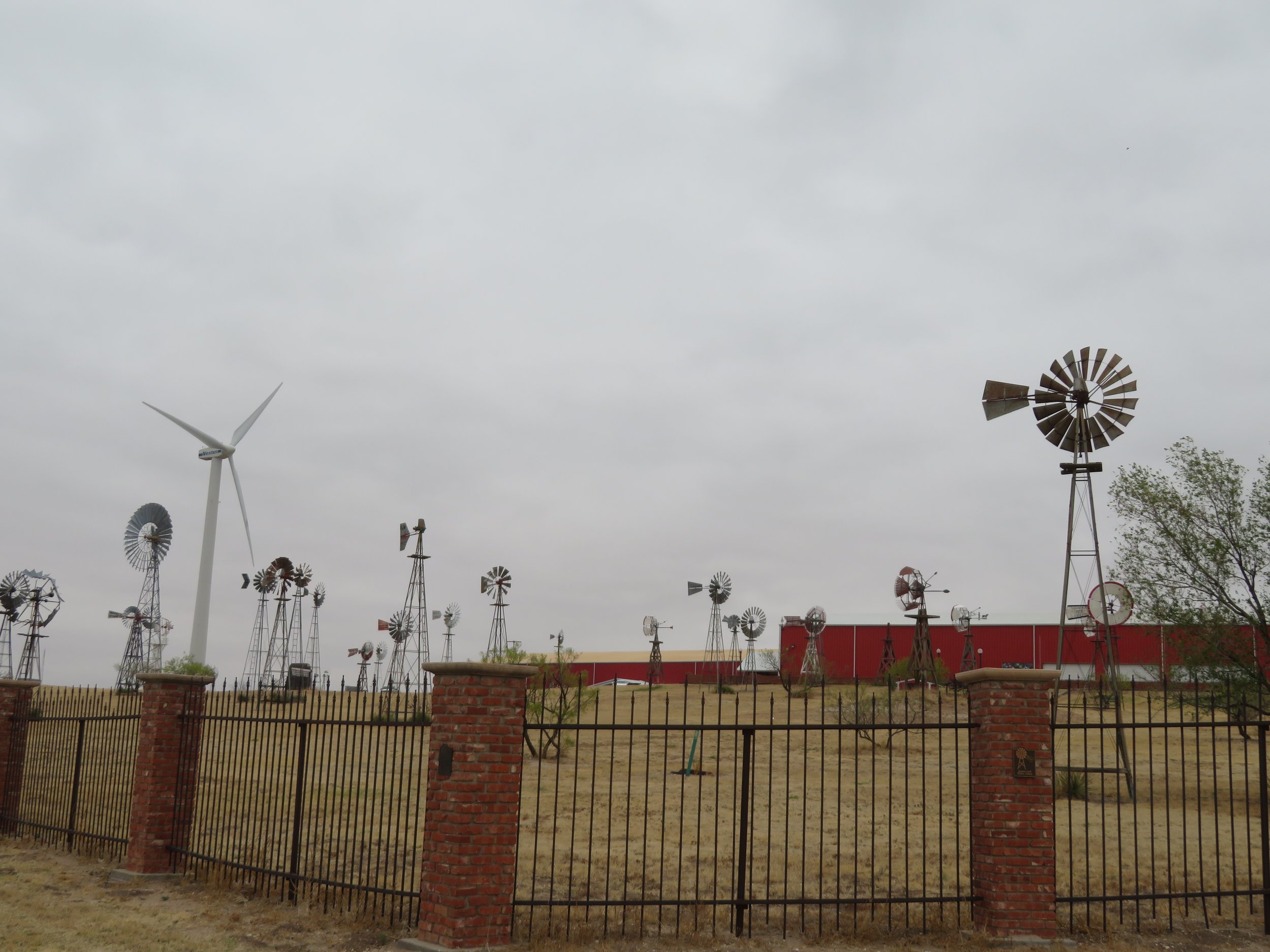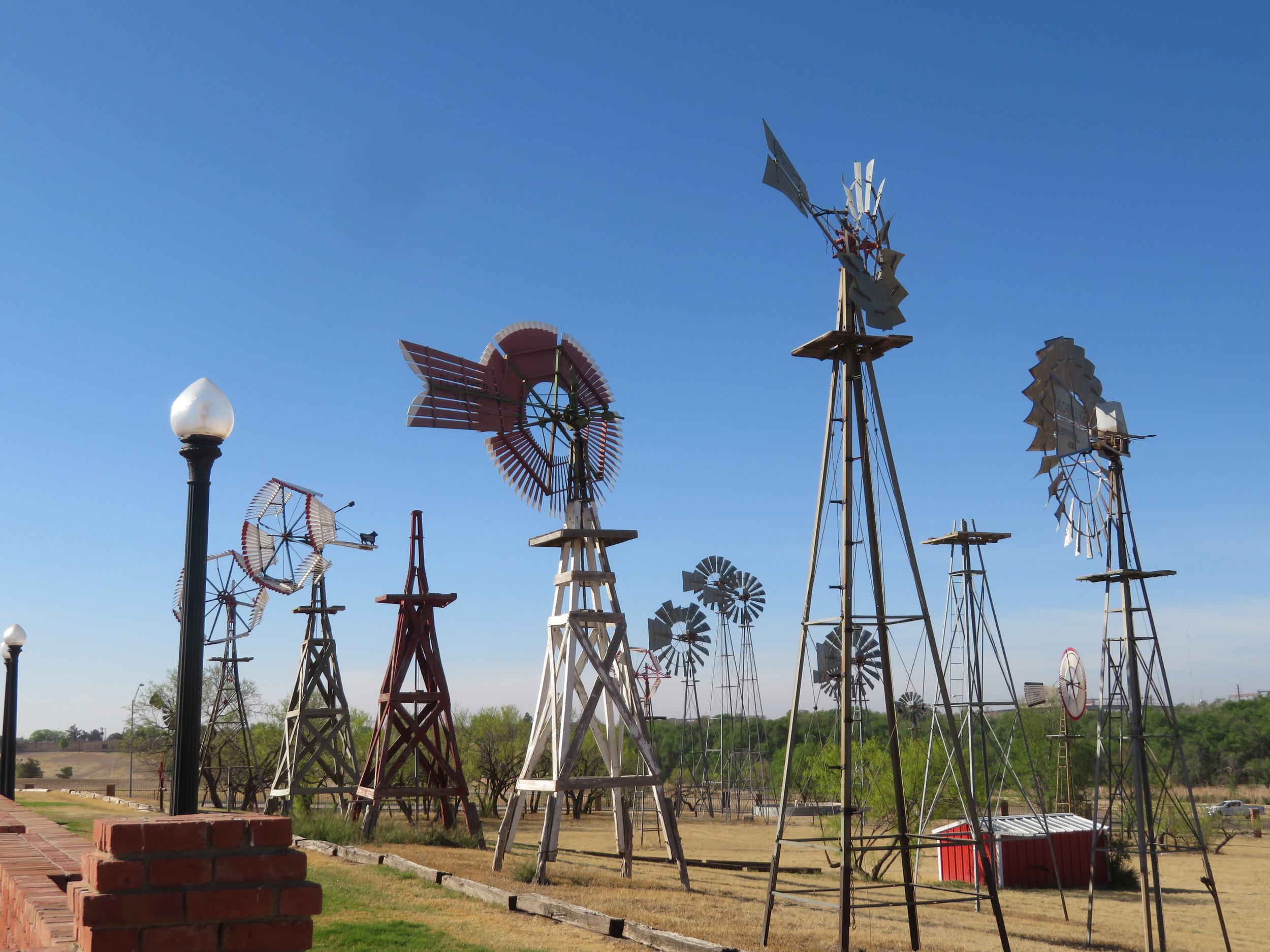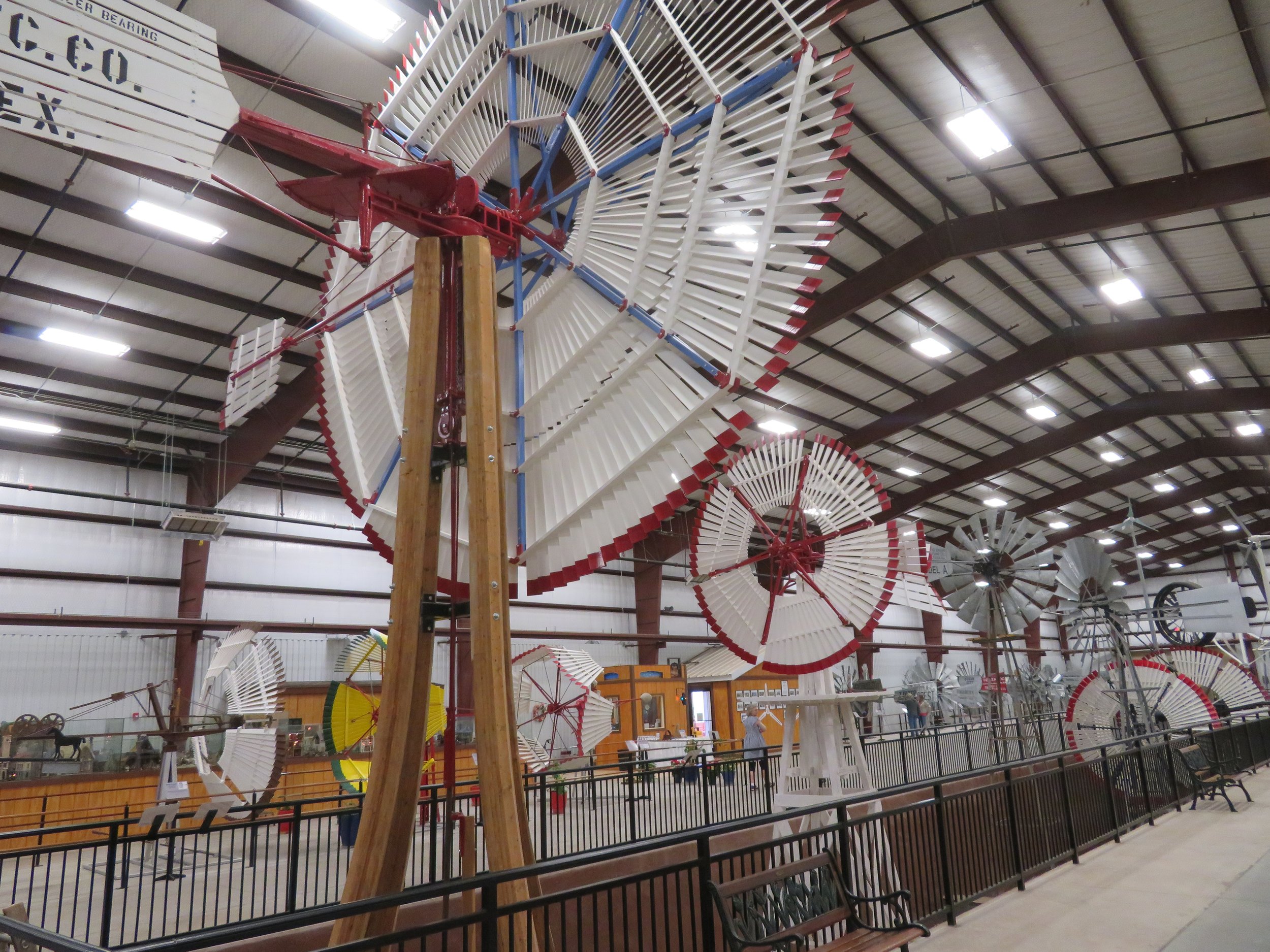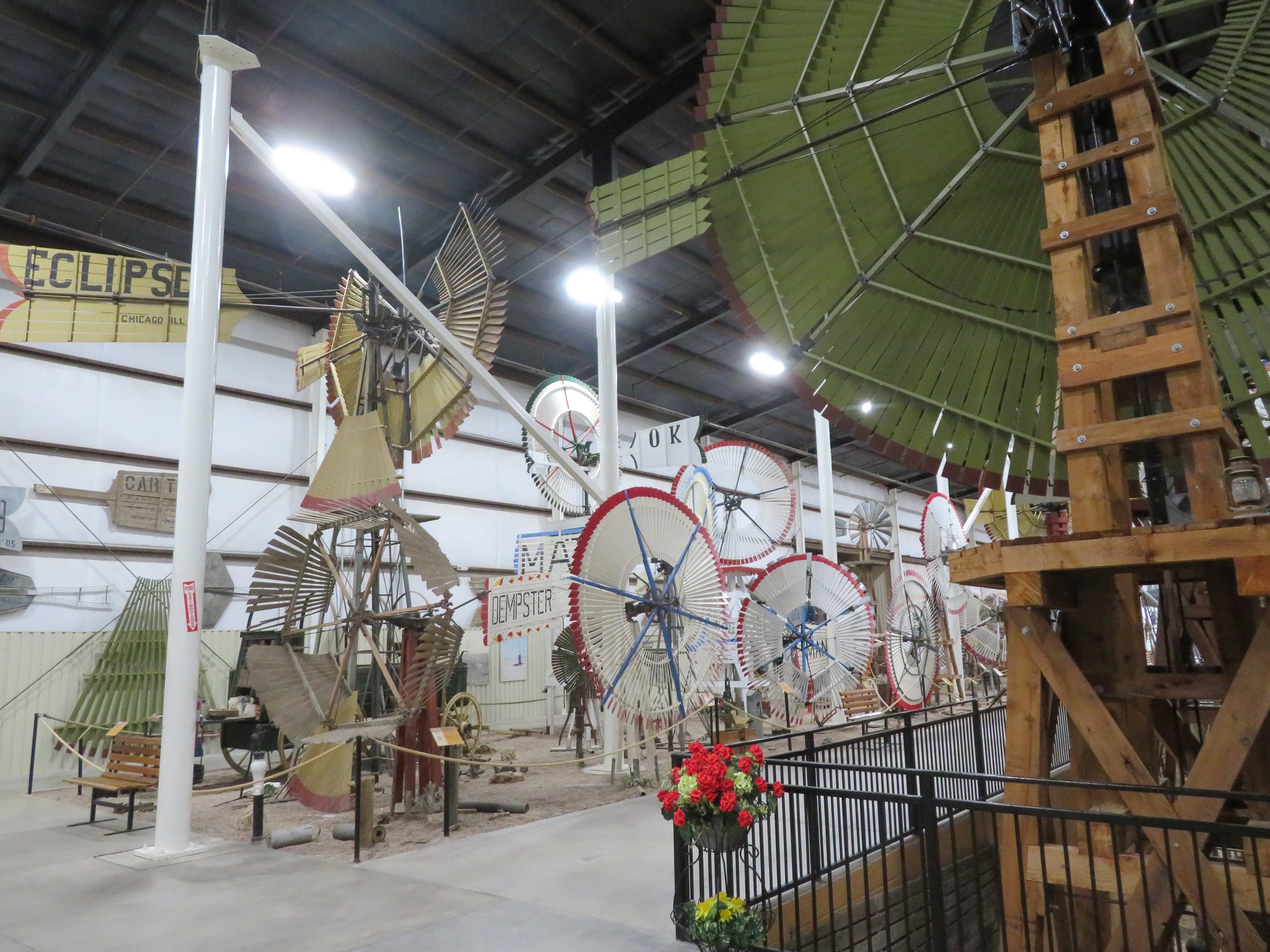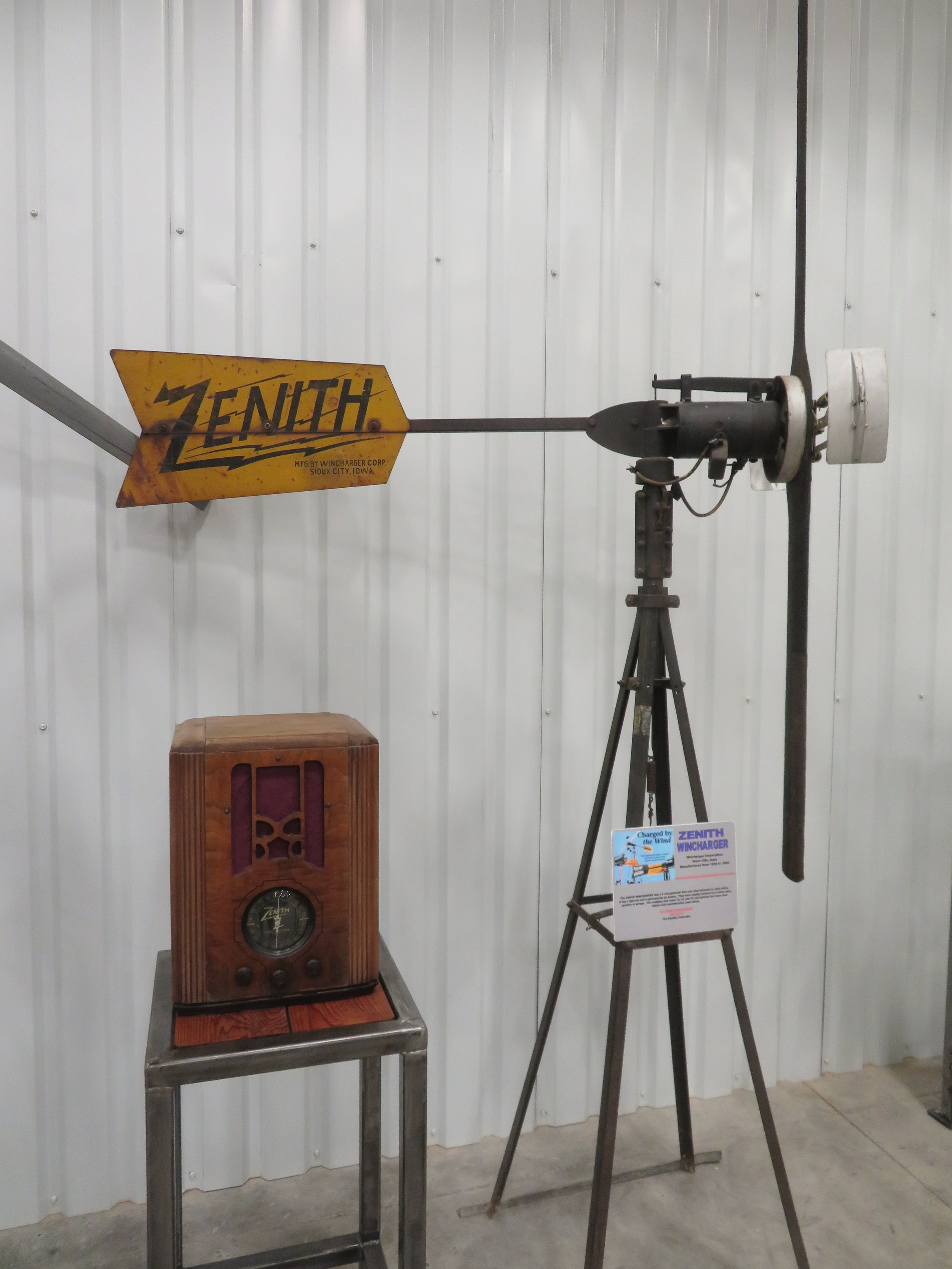Blue View – Windmills
/The entrance to the American Windmill Museum
As Marcie mentioned in her last blog, one of our stops while in Lubbock was the American Windmill Museum. Once again, what I expected to be offbeat, but of only middling interest, turned out to be fascinating. The museum has literally hundreds of restored windmills of all vintages and types. What I found especially engaging was how these various windmills evolved, and the clever designs and engineering that went into them.
About Windmills
Windmills convert wind power to rotational energy which is then used to perform some useful functions like grinding grain, pumping water, or generating electricity. Many of these uses, like grist mills for grinding grain, date back hundreds of years but have been, for the most part, replaced by the internal combustion engine or electrical motors. There are still a few operating grist mills around – we’ve seen one or two in our travels – but most are now operated solely to preserve their historical significance. Two applications, however, are still very common… water pumps and electrical generators.
A collection of millstones
Water Pump Windmills
You cannot drive through the rural areas of the Midwest or western America without seeing windmills. They are iconic of American farming and ranching; they were, and still are, used primarily for pumping water from wells. They are easy to pick out with the tall, forty-plus foot tower, fan-like wheel, and tail that acts like a rudder to keep the fan facing into the wind.
An iconic American windmill
The first American windmill was invented in 1854 by a machinist named Daniel Halladay. It was considerably different from the windmills in other parts of the world. These were self-governing – turning into the wind when winds were light and turning away from the wind in higher winds, making them efficient at almost any wind speed. They also required less maintenance than previous designs. Finally, they could be dismantled and shipped, making it possible for farmers and ranchers to order them from the manufacturers.
From the U.S. Park Service “Self-governing water pump windmills soon became a staple on the plains. Homesteaders, farmers, and ranchers were no longer dependent on natural water as they could drill wells and pump water. Windmills were often among a homesteader’s most prized possessions. The water pumped by windmills was used to cook, bathe, drink, water crops and animals, wash clothes, and more.”
Dozens of companies began designing and building windmills, and it’s estimated that as many as six million windmills were erected in the fifty years following Mr. Halladay’s invention. Their prevalence began declining as rural America became electrified in the twentieth century, as many of the windmills that provided household water were replaced with electric pumps. The windmills that pumped water for the livestock “on the south 40”, however, are still often operational, although even these are being replaced with solar-powered electrical pumps.
Electricity Generating Windmills
Electricity generating windmills, or wind turbines, have been in existence since the late 1800s. According to Wikipedia, the first wind turbine used for the production of electricity was built in Scotland in July 1887 by Professor James Blyth of Anderson's College, Glasgow. Blyth's 10m high, cloth-sailed wind turbine was installed in the garden of his holiday cottage and was used to power the lights in the cottage, making it the first house in the world to have its electricity supplied by wind power. Blyth offered the surplus electricity to the people of Marykirk for lighting the main street, but they turned down the offer as they thought electricity was "the work of the devil”.
Shortly after Prof. Blyth’s wind turbine, Charles Brush, in 1888, built a larger wind turbine in Cleveland, Ohio. The Brush wind turbine had a 56-foot diameter rotor and was mounted on a 60-foot tower. It was rated at 12kw and powered the lights and motors in Brush’s laboratory, but fell into disuse after 1900 when electricity became available in Cleveland.
A typical wind turbine circa 1930
Wind turbines during the twentieth century followed the same path as the water pumping windmills… they were used extensively in rural areas and other places where the electrical grid wasn’t available, but fell by the wayside as the electrical grid became more widespread.
With rising fuel prices and the fuel shortages that began in 1973, however, interest in wind turbines was renewed. At about the same time, a back-to-the-land movement began growing, and several companies developed small units that could power individual houses and boats. We even had two aboard our sailboat Nine of Cups which, in addition to three solar panels, provided most of the power we needed on a typical day. But the real interest was in the large turbines that produce megawatts of power. An average modern wind turbine can now produce enough power for more than 420 U.S. homes. As of January 2022, there were an estimated 70,800 turbines in the U.S. in approximately 1500 wind farms. The largest onshore wind farm in the world is the Roscoe wind farm, 45 miles southeast of Abilene. With 627 turbines, it can produce 781 megawatts… enough to power 265,000 homes!
Repairing the windgen on Nine of Cups… in my YOUNGER days
These turbines are huge. You’ve probably seen the parts being transported on the interstates. Usually, each blade is transported on an extra-long trailer. Note that a usual trailer is 53’ long while a turbine blade is typically 116’ long – more than twice the length of a standard trailer. The nacelle, the house-like box at the top of the tower, is about 34’x12’ and sometimes weighs as much as 80 tons – close to the maximum weight allowed on U.S. highways. To get the blade high enough to clear the ground (and any unwary person or vehicle), the tower is between 263 and 410 feet high – somewhere between a 26 and 41 story building. The tower is shipped in sections and assembled at the site.
I’ve always wanted to see one of these guys up close and maybe have a look inside, but I never had the opportunity… that is until we visited the American Windmill Museum. They have a working Vesper wind turbine as well as the dismantled parts of several other, older wind turbines. A docent at the museum, Jason Miller, was kind enough to give Marcie and me a tour of the working turbine – which provides ample power for the museum along with a surplus that is sold to the local utility.
Something I’ve long wanted to do was see inside one of the big guys
One of my first questions was how does one climb to the top. Is there a circular staircase like in a lighthouse? An electric winch to hoist you up? Nope – just a very basic steel rung ladder, in this case, 35 stories high. Workers are required to wear a harness and clip onto a cable before climbing all those steps. I mentioned to Jason that it would be par for me to climb all the way to the top, then realize I’d forgotten my screwdriver. He said not to worry, tools are hauled up in a bag after climbing to the top, and someone below can always find that tool I’d forgotten and stick it into the bag.
Jason was kind enough to give us a tour of the inside
It’s a long climb to the top
Workers are required to harness-up and wear a helmet
For safety reasons, visitors aren’t allowed to climb the ladder, which is my excuse for not climbing those steps. After looking around the working Vesper, we examined the various parts of the wind turbines that were on exhibit in a nearby field. Up close, everything is much larger than it appears from a distance. We could have used the nacelle as a garage for Blanche if it wasn’t chock full of gears, switch panels, computer modules, and one very large generator.
That’s one big propeller!
There’s a lot of gear inside the nacelle
We found the museum so interesting, we spent a day and a half exploring all it had to offer. Then, all too soon, it was time to start heading home.
See you next week as we return to Las Vegas and complete another round of upgrades for Blanche.



